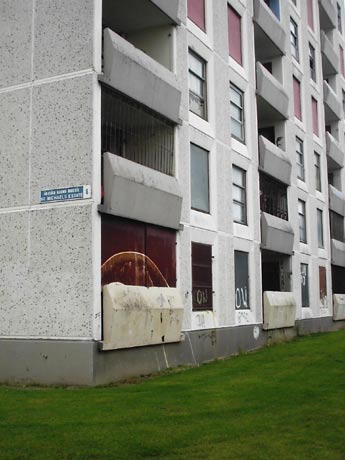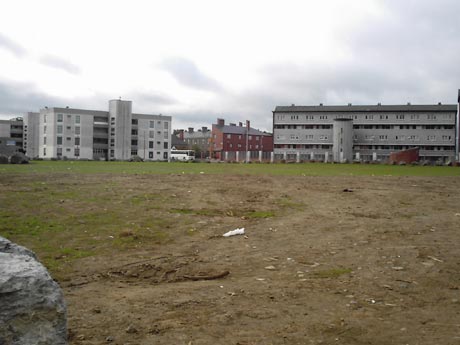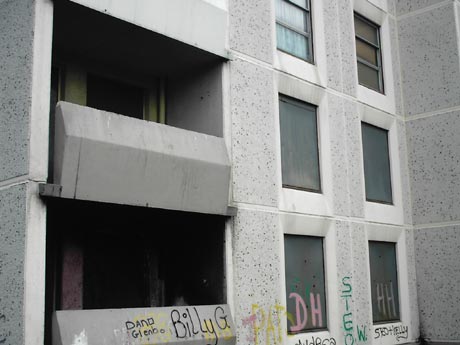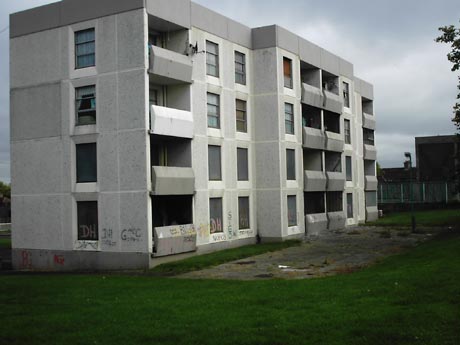|
Rights, Freedoms and Repression
Blog Feeds
Anti-Empire
The SakerIndymedia Ireland is a volunteer-run non-commercial open publishing website for local and international news, opinion & analysis, press releases and events. Its main objective is to enable the public to participate in reporting and analysis of the news and other important events and aspects of our daily lives and thereby give a voice to people.
Public InquiryInterested in maladministration. Estd. 2005
Voltaire NetworkVoltaire, international edition
|
Living with state dereliction in St Michael's: local community rejects privatisation of their homes dublin |
rights, freedoms and repression |
feature dublin |
rights, freedoms and repression |
feature
 Tuesday October 12, 2004 12:38 Tuesday October 12, 2004 12:38 by kevin - imc éire by kevin - imc éire
 Interview with community activist Rita Fagan - download the MP3 A local community rejects Public Private Partnerships.
Click here to download the MP3 interview from radio.indymedia.org with Rita Fagan. Transport and airport workers, along with Aer Rianta and SIPTU officials, may have been dancing a jig of schadenfreudic glee at the clipping of Seamus Brennan's wings from his post as Minister for Transport; but his replacement Martin Cullen, is no stranger to privatising public resources. During Cullen's time as Minister for the Environment, he presided over the M50/Carrickmines saga, and also pursued the construction of the M3 through the Tara Skreen Valley with renewed vigour. His commitment to public transport is minimal. He also undermined the local democratic process in Dublin by imposing a PPP (Public Private Partnership) on St. Michael's Estate in Inchicore, usurping years of consultation and negotiation with the tenants of the estate. St. Michael's Estate was built in 1969, at the same time that Ballymun rose up on the other side of the city. The community within the estate has a long history pre-dating the construction of the flats. Originally Richmond Barracks during English rule, it was given over to the new Free State Army in 1923. In the 1940's the Army moved out and the land was given to Dublin Corporation (now Dublin City Council). Around this time the area was known as Keogh Square, which was primarily composed of tenements, and had the name of being a slum on the city fringe. When the flats were being built, there was a huge demand of people who wanted to be housed there. There was heating, green spaces, and of course high-rise communities were viewed as the way of the future. In the late 1970's and early 1980's the social and living conditions on St. Michael's Estate started to decline. Working families were given housing grants of £5,000 by the Council, so many of them simply moved out. Single parents were given flats, and the Council rarely investigated the people it was housing. What was once a traditional stable family society became a single parent society, and this created gaps and imbalances in the social fabric. The long-term residents of the estate were increasingly exasperated with the Council officials making decisions in the city centre without any local consultation, and so in 1986 a group of women set up the St. Michael's Family Resource Centre, which is located in a ground floor flat on the estate. Through the 1980's the tenants were only seeking improvements and refurbishment to their homes. The heroin epidemic in the early 1990's killed a lot of the sense of hope and community people had, so by 1998 people no longer wanted refurbishment. The Council conducted an official survey of the tenants' wishes, and aside from those who wanted to pack up and leave, the majority of the others favoured complete demolition and redevelopment of the Estate. They wanted simple houses with gardens. Following this, St. Michael's Task Force was set up, and a low-density redevelopment plan was agreed with the local tenants. 170 local authority units were to be built, so people who so wished could stay and live in the area they were living in already. There would be 80 affordable homes built, and then 70 fully private units which were apartments along the canal. There were 3 crèches, a new resource centre, an after-school building, and green spaces. Rita Fagan is a community worker in the St. Michael's Family Resource Centre, and her frustration at the current impasse with the Council was evident when I talked to her. "The plan we worked on had a deep consultation process on the estate. We were given an architect to work with us. A huge amount of money was put into that process. The plan was finalised and sent off the to Department of the Environment. It was like signing off on the Good Friday Agreement, we had put so much work into it. We had worked very closely with the Council with the first and second phases of the plan. 51 families were transferred to a site at Goldenbridge after blocks 1, 2 and 3 were demolished. We also worked closely with them for the building of Bulfin Court, which are another 50 units just down the road from St. Michael's Estate. There are seven blocks with 60 families remaining on the estate." In September 2003 the redevelopment plan was rejected by Martin Cullen. A communiqué from the Department of the Environment was sent to the Council, stressing the need for PPPs in April 2003. Rita says that what really shook the community was the rejection of the plan by Cullen, and the fact that Dublin City Council officials went and sided with the Minister. "The Council had worked with us very closely and instead of staying on our side, and fighting with us together, they did a U-turn. From then on they closed the door on us. They said they would draw up a new plan, based on some aspects of the old one. What actually happened was they got the architects to draw up a new plan completely different from our one. The new high density PPP plan consisted of 850 units. 550 of them were to be sold privately. 220 were affordable for first time buyers, ultimately also private, and only 80 social housing units. The social housing units were going to be duplexes. The people were not going to get the houses with gardens they were promised. We don’t believe that high densities or apartments are family friendly at all. There's no community there, you lose your community. It’s a different form of living. " In April 2004 the St. Michael's tenants launched a campaign to go out to the wider area and collect signatures, to get the original plan back on the negotiating table. They collected over 3,200 signatures, and handed them to the City Manager on June 30th, which was the same day the Council was launching its framework plan. In July they held a public meeting which was attended by around 200 people. The new plan was unanimously rejected by the people present. On September 6th, after extensive campaigning, the plan was rejected by the Councillors. The City Manager and Assistant City Manager expressed their dissatisfaction with this decision, and vowed to try and press ahead with the revised high-density plan. Walking around St. Michael's Estate today, you can see that a large percentage of the flats are boarded up and left derelict. In the inner city, flats in blocks like Ellis Court on Benburb Street, or on Moss Street and Luke Street near the Ulster Bank Complex on the south quays, are also covered up with the ugly steel partitions. This is commonplace in blocks that are still structurally sound, despite the Council having a housing waiting list of over 7,000. Rita believes this is part of a wider sinister policy being orchestrated by the Government. "These buildings are identified for Public Private Partnerships. PPPs mean that Dublin City Council will get a number of things done for them and they'll get money into their hands to deal with their own bills. This policy is dangerous because when you begin to take working class communities out of the city, you are displacing vulnerable people. They run the flats down on purpose. The necessary maintenance isn’t done. People find it very hard to live and want to move out. They did that 30 years ago and took people out of the city, and out to Ballymun, Tallaght, Clondalkin. People's families and support was in the city centre. People felt very isolated. They became depressed, particularly when they were in poverty and didn't have many choices. It’s different when people have the choice to buy houses. When your life is in the hands of other people it can often be total misery. "I think the policy of setting up PPPs is not just Dublin City Council. It’s coming from the top. A decision was made in the Department of the Environment by Martin Cullen. There's money to be made, huge profits. So the Council see an opportunity to make money out of managing housing. They don’t really want to manage it. They like to build, they like to give the impression as the leaders of the city. But under the UN, everyone is entitled to housing. The people on our streets who can’t afford it must be guaranteed a place to live. That's our duty as a people. The Council don’t have the right to sell off local authority land when there's a waiting list of 7,000. That's just the waiting list, you're not counting people on other people's floors and couches. The City Managers are claiming that the tenants campaign has put the development of the estate back by five years. Rita argues that their practise has put back the idea that communities can work with bodies like Dublin City Council. "This has put back the idea of participatory democracy, or building peoples confidence, or believing that you can actually sit down and make a change together for a better life of the city. "I think the choice was made to take the decision out of the hands of the community because there's a lot of right wing thinking going on in the world at the moment. This thinking believes that privatisation is the only way forward for all of us. Here on the estate we may not have much political power but we have stopped a 200 million euro development. This wasn’t what we set out to do originally though. What we wanted for the poor people here was for them not be displaced; that they get to live in their communities, that their culture is valued. We wanted recognition that we belong to the city just as much as the rich belong to the city. I think that's a really important value. "The thinking of Charlie McCreevy and Martin Cullen means that the Council will pursue all efforts to get this land at the expense of the 60 families left on the estate. This land is so valuable. Its fifteen minutes from the city centre. The LUAS is now running nearby. You're near the Phoenix Park and the Museum of Modern Art. The families left here are our priority now. We want it to go back to a task force so we can work out agreements. They're telling us it’s been put back for five years but to me that's blackmail. I don’t think that any City Manager or Assistant City Manager has the right to treat people like that. It’s a total disgrace if they sulk like this and won’t continue to work with us. "Our rejection of the privatisation of St. Michael's estate has given a lot of hope to places like O'Devaney Gardens where the same process is happening, and privatisation is being pushed and pushed on the community. That's a 16-acre site close to the Phoenix Park, so the people there have a real battle on their hands. It's also happening with Chambers Street in the Coombe, being redeveloped as a PPP. The old Council area housing density was 8 people to the acre, now ordinarily it is 60 to the acre. The Chambers Street development aims for 120 to the acre. That's just pure greed. It's not just about St. Michael's estate, it's about all these communities around the city." Dick Roche takes over from Martin Cullen as Minister for the Environment. It remains to be seen whether he will push the privatisation of public housing as much as his predecessor. Local heritage, conservation, and environment groups are nervous, with one contributor stating on archiseek.com: "Dick Roche goes into environment and Cullen into transport. Predictions: Metro killed stone dead. Motorway building programme accelerated. Heritage lobby groups eradicated." In the meantime the residents of St. Michael's are looking for some kind of legal binding on any future decisions reached with Dublin City Council, so officials and politicians higher up the chain cannot hijack the process and impose their own decisions. This has previously worked with the regeneration of Fatima Mansions - which was actually a PPP scheme, but one which the residents were happy with because they were involved at every stage in the negotiations, and they felt they got a fair result for the community there.
|





























 printable version
printable version

 Digg this
Digg this del.icio.us
del.icio.us Furl
Furl Reddit
Reddit Technorati
Technorati Facebook
Facebook Gab
Gab Twitter
Twitter
View Comments Titles Only
save preference
Comments (13 of 13)
Jump To Comment: 1 2 3 4 5 6 7 8 9 10 11 12 13Five more photos.
Interior of derelict blocks
New housing development at Bulfin Court - excellent example of social housing working in a community
The towers - note high number of red and black boarded up windows.
http://www.anphoblacht.com/news/detail/6788
Two page feature in An Phoblacht of 7th October.
I think the key problem here is visible from the pictures above. The depopulation of the estate has probably effectively justified the large reduction in the number of social units available. It would be interesting to know exactly how many existing units there are, and how exactly the corporation plans to deal with people who may be total put out of a home?
I remember a similar plan being pursued in the Gardiner St area in the city cerntre in the late 1980s, where all assistance was refused to local groups attempting to create local employment in the area, so it wouldn't interfere with powerful developers plans for the street. Basically it was a deliberate attempt to force people to leave the area, so that it would become ripe for "redevelopment."
There's 60 families left there, so presumably that's 60 units currently occupied. From walking around there, I would guess the occupancy rate is around 40 - 50%. Hard to say though.
Would there be 80 or so homes left empty or boarded up? That would be my closest guess based on those figures.
So this isn't going to be well recieved but; Why exactly should I be outraged by the fact that the state isn't going to be giving out as many city homes as these people want, in the exact way that they want?
Most people would love a practically free house and garden in the city. Instead they have to move to Kildare or Wicklow, even as far as Mullingar and Portlaoise if they want to own their own house. (And no matter what you feel about private property paying rent to a private landlord is a mugs game). So they commit to spending the next 20-35 years of their lives to paying off the cost of an uninspiring semi-detached box, in a soul destroying suburb 2 counties over from the city the work in, in most family cases both parents working full time, condemed to spending 2-6 hours a day in their car. While some people are complaining that the state won't give them a lovely house and garden in Inchicore.
Rita Fagan said it is different when you have the choice to buy your own home, but having the choice to continue renting an over priced city apartment (not all that different in terms of space and garden from your average tower block, although I will concede usually prettier and safer) or buying a house in Mullingar is not much of a choice at all.
I'm not saying that everybody isn't entitled to have someplace safe and decent to live and everybody no matter who they are or what their circumstances are should be provided with the means to acheive this. But the fact remains this isn't a fair world and if the vast majority of people are being fucked over by the current system then no small group of people can expect everything because they have a ridiculous notion that everyone but them has everything.
Someone who has worked hard and sacrificed all luxuries to buy their own home can have far less money in their pockets every month than someone in corporation housing and recieve far less benefits.
It's the system that needs to change, for everybody, not just 60 families in Inchicore. Nothing will ever change as long as people are only out for themselves.
“The plan we worked on had a deep consultation process on the estate.
“51 families were transferred to a site at Goldenbridge after blocks 1, 2 and 3 were demolished.
- And then, betrayal, the plans were scrapped when
“A communiqué from the Department of the Environment was sent to the Council, stressing the need for PPPs in April 2003.
Where the fuck did Housing PPPs come from?
I don’t know if the article demands that you be “outraged”.
It does suggest to me a spot of gardening
as part of a “system change”.
The fact is the St Michaels issue that the local community are empowering themselves directly at a local level by demanding a say in developments that largely affect their lives. If they were to sit back and criticise each other for not challenging the broader system they would have been shafted out of the area long ago.
You see, if you want to challenge the system that has us all fucked over you have to start with the local or small things that directly have you powerless. Working class people are well aware of the fact that the middle people are trapped aswell but I doesn’t make sense for them to go trying to save the world as it only dilutes the energy they can put into their own cause...If middle class people are fed up with their lot well then stop voting the feckers in, and stop laying back and allowing yer life to be controlled by the powers that be and using apathy and far fetched radicalism as an excuse to distract from effective movement by people who are organised.
When oppressed people realise their own situation, get disgusted, get active and get organised well then we as people irrelevant of class might be able to join up our efforts, but so long as we sit around saying 'not just for 60 people in Inchecore'.. well then we'll only remain disheartened, disunified and we will remain demoralised.
Fair play to Rita and all at St. Michaels, stick together!
My famile was one of the first to move into St Michaels Estate and as a kid i watched the rest of the Estate being built. I met some lovely people over the years and during the summer months we had family outings.
What i am trying to say is the problem with the Estate is down to the City Council and who ther allowed to move into the Estate.
We moved out of the area and saw a once lovely estate go downhill fast.
I just hope people learn from this and remember to manage means to be in control.
That lady has it in one.Very articulate.Its a straight land grab to enrich both the city council and the Sean Dunne types who have to pay 200 million or more for a similiar site in Ballsbridge.
Its the public private partnership -."
Impoverish the public- make billionaires out of Bertie's private backers-the Bailey Bovale set etc".
It appears that nothing will stop it,unless communities throughout Dublin join together and give support to one another.Its Inchicore today, Ballyfermot tomorrow, the Liberties next week...
Unite or be defeated.some hard work ahead.
this was a nice area, but was made a slum by Dublin City Council who could not have been more disrespetful to the residents if they tried.
I was in the first block and after a small few years a lot of my neighbours were advised to move to Clondalkin for a better life.
People were starting to look at the flats as a haven for scum the council aided this perception and may thay all go to hell for there sins.
The real question right now is, Why are Dublin City Council allowing McNamara Construction to say that the PPP regeneration Plan for St Michael's is no longer viable due to new regulations about energy efficieny (which were requirments in the tendering document )and apartment sizes?.
He has already been generously compensated ( well in to the millions) for the purposed apartments he may loose by increasing the size of apartments in line with new regulations.And he has also gotten over 1 million for construction and inflation costs and interest increase costs. McNamara is getting a great deal.
What is the purpose of Dublin City Council in the PPP process?. They need to get on with regeneration fast and develop the 14 acres as agreed. They need to look after the residents need's not the builders!
Anyone know if McNamara did much time in the Galway Tent?
im was born and reared in st michaels est. .who do u blame 4 the state of the est .the council or the people.i blame each other .it was a great place to live .but over the years scum moved in to the est and ripped it apart.i remember the xmas partys in the local youth centre it was always a great place as a kid .but by the time i got older it was drugs robbed cars robbed flats.where s the so called great community spirt then neighbours robbing each other.i remember my father every year painting the landing .curtains on the landing window.yes the councils stalling on new houses .do people in st michaels deserve a new house.when there flats are dirty and smelly.makes no diffrence where u live if you dont respect what you have now .exmple look at new sports hall beside the church its shocking and embrasseing to see.is this our local spirt .well keep it .time will tell if there s a future in st michaels.yes i feel sad 4 what st michaels use to be .who remembers the discos on the tarmac ..santa going around the flats giving all us kids presents .peppers the local nite club .were us kids stood on the community centre railing to watch the fights .playing in the graveyard.swimming in the canal .oh happy days .but now theres ?
I WAS BORN IN 127 KEOGH SQUARE IN 1962,NOT ONLY DO I REMEMBER ST MICHAELS BEING BUILT BUT ALSO LIVED THERE FOR THE BEST PART OY 40 YEARS.I HAVE MANY HAPPY MEMORYS OF GROWING UP THERE.I MISS LIVING THERE VERY MUCH,WE HAD THE BEST OF NEIGHBOURS AND FRIENDS.IVE NOW HEARD THAT THE SCHOOL IS TO BE PULLED DOWN,IS IT TO MAKE RICH PEOPLE EVEN RICHER SHAME ON THEM.UP THE BARRACKERS